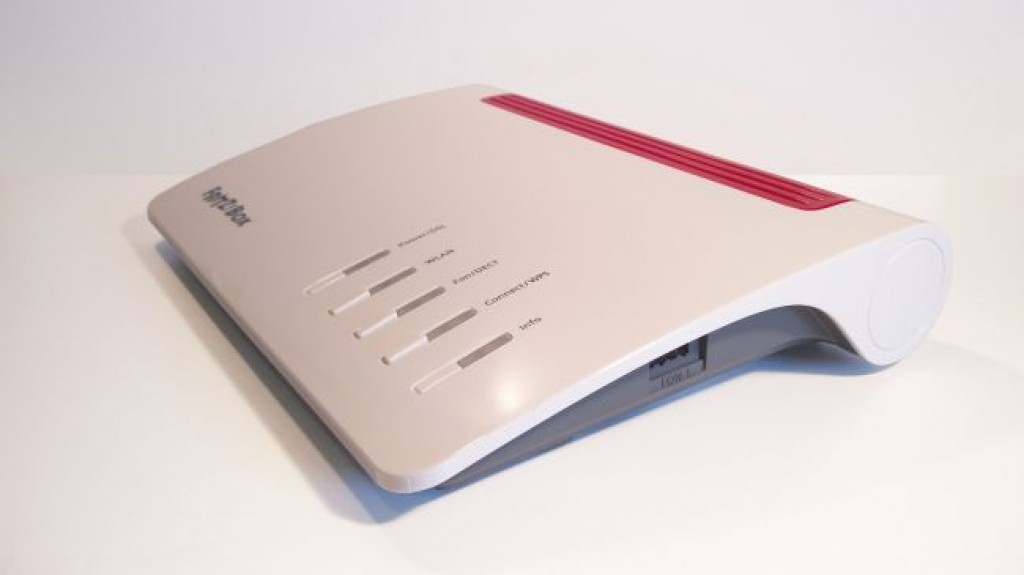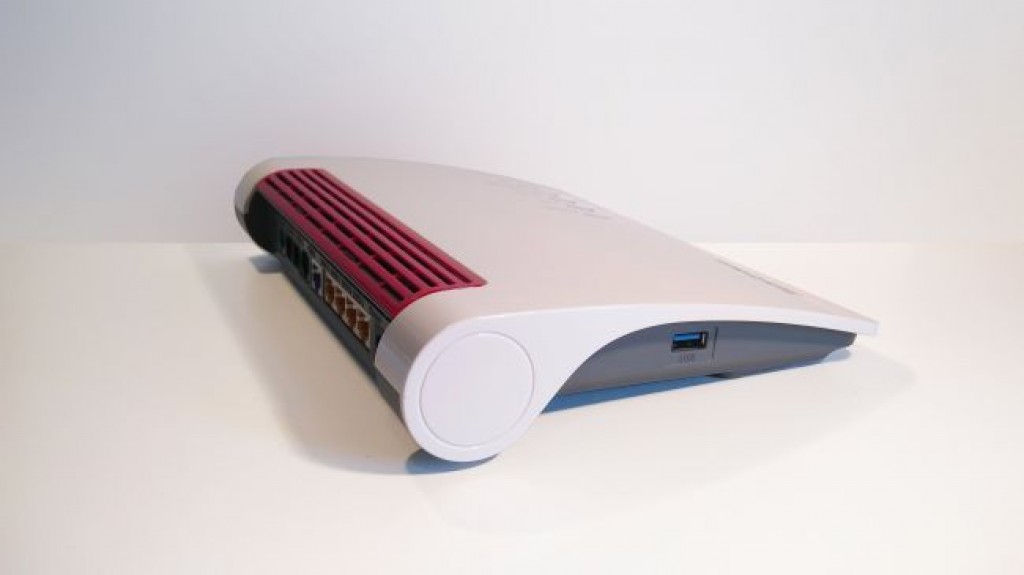
OUR VERDICT
An immensely capable router with a huge number of features, comprehensive firmware, some slightly dodgy external design, and price that’s just a little too high. If you want to do more with your network, it’s a solid pick.
FOR
- Loads of features
- DECT compatibility and 4G fallback
- DSL and Cable compatibility
AGAINST
- Wonky looks
- Mid-range Wi-Fi performance
- A little pricey
Whatever you might think about the slightly startling name, the latest FRITZ!Box (and we do insist on replicating that styling correctly because, come on, it’s hilarious) does more than its jaunty logo and wacky, dated styling might suggest.
In fact, it seems it’s absolutely insistent on doing everything it possibly can. It routes wireless traffic, it routes wired traffic, it routes DSL and analogue phone lines, it manages DECT phones, printers, network storage.
Plug in a 4G dongle and it’ll even provide fallback connectivity for your network in case of a main connection outage. You are entirely unlikely to need at least half of its features, but if you’re craving a router with flexibility you’ve definitely found it.
The real question, though, is do we want this in our house? Does that flexibility warrant the price? Are we really prepared for visitors to ask what a FRITZ!Box does?
Those questions are answered not just by the FRITZ!Box 7590’s wide range of almost enterprise-level features, but by the fact that it almost keeps pace with similarly-priced competitors in terms of performance and power.

Price and availability
The German-made FRITZ!Box 7590 is, as you might expect, widely available across Europe, coming in at somewhere around £265.
That’s a whole lot of money for a router, particularly if you’re not looking for more than its base features, but if you’re administering a SOHO (small office or home office) situation, or you’re just really serious about your home connection, its myriad ports and possibilities might just make that a reasonable outlay.
We’re yet to find it listed for sale in the USA (though its considerably uglier 7490 predecessor did land on those shores, so there’s a chance), and Australia is also waiting; expect a similar US dollar price, and the usual hefty Australia markup.
Design and setup
We may have muttered slightly facetiously earlier on about the number of features the FRITZ!Box 7590 squashes in to its small frame, but AVM has at least done a fabulous job of putting them in a small space.
The new-look design, which adopts a couple of styling features from its classic predecessors but chucks out the retro-futuristic fins, is sleek, offers good airflow underneath, and can be wall mounted if you choose.
It’s also visually very different from most routing hardware, opting for a grey/dark grey/dark red combo that’s uniquely FRITZ!Box.

This is a great router for VDSL users – including BT Infinity subscribers – or at least it will be, thanks to its support for VDSL 35b super vectoring. Essentially this is a way to tease up to 300Mbit/s out of twisted pair cabling, presuming you’re on a short enough hop to the cabinet. No UK ISP supports it at this time, but it’s good to be prepared for the future.
The 7950’s rather unique DECT phone support is also a pretty big deal, particularly when tied in to AVM’s excellent FRITZ!OS firmware and FRITZ!App phone application; support for Fon means that you can route your calls as you wish, and even make landline calls, after a fashion, through your mobile.
That’s not the only app that can manage the router’s features – there are four or five on offer covering a host of different aspects.
Performance
All of those features plus world-beating performance might have been too much to ask, and so it proved, as the FRITZ!Box 7590 didn’t blow away our performance tests.
It’s not bad, by any means, but middling Wi-Fi performance puts all those additional extras (and the 7590’s pretty high price) into perspective if you’re not going to take full advantage of them.
Without access to VDSL we weren’t able to test the super vectoring performance, but realistically you should be able to take the theoretical maximum of 300Mbit/s with the same pinch of salt applied to most internet speed ratings – it’s all going to depend on the distance to the cabinet, the quality of the cabling used on your local loop, your ISP’s temperament on any given day. All things that the FRITZ!Box has no control over.
Control, though, is its real strong point. FRITZ!OS is a great firmware frontend packed with wizards and diagnostic tools that make configuration easy, and it continues the enterprise-aping feature set with some pro-level tweaks. Fancy dropping the Ethernet ports from gigabit to 100Mbit to save a bit of power? Disabling Wi-fi on a schedule? Blocking pings, filtering ports, and everything in between? Done.

We liked
It’s great to have so many options and the FRITZ!Box 7590 offers more than you could ever truly need.
For a SOHO situation, it’s a good one-stop shop that’s easy enough to micromanage and expand as the situation dictates – and the app management and comprehensive firmware put those controls at your fingertips.
We disliked
That raft of features, outside of very specific use cases, just isn’t required, so paying a little extra for mid-range Wi-Fi power might sting.
Credit to AVM for building a router that, like its forebears, doesn’t look like any other router out there, but its visual appeal is questionable at best.
Final verdict
The FRITZ!Box 7590 (we’re still tickled by the shouty capitalisation of that name) is a bit of a surprise. It’s not the feature set, or the striking look, or the comprehensive firmware that does it – it’s that this is an inherently likeable, capable, versatile router that makes us want to experiment.
What home doesn’t need its landline turned into something actually useful? Why not centralise storage, printers, and the like? This changes our view of what a router should be – the only problem is that it’s not, in its price bracket, quite as good at the bits that really matter.
Source: techradar.com









































